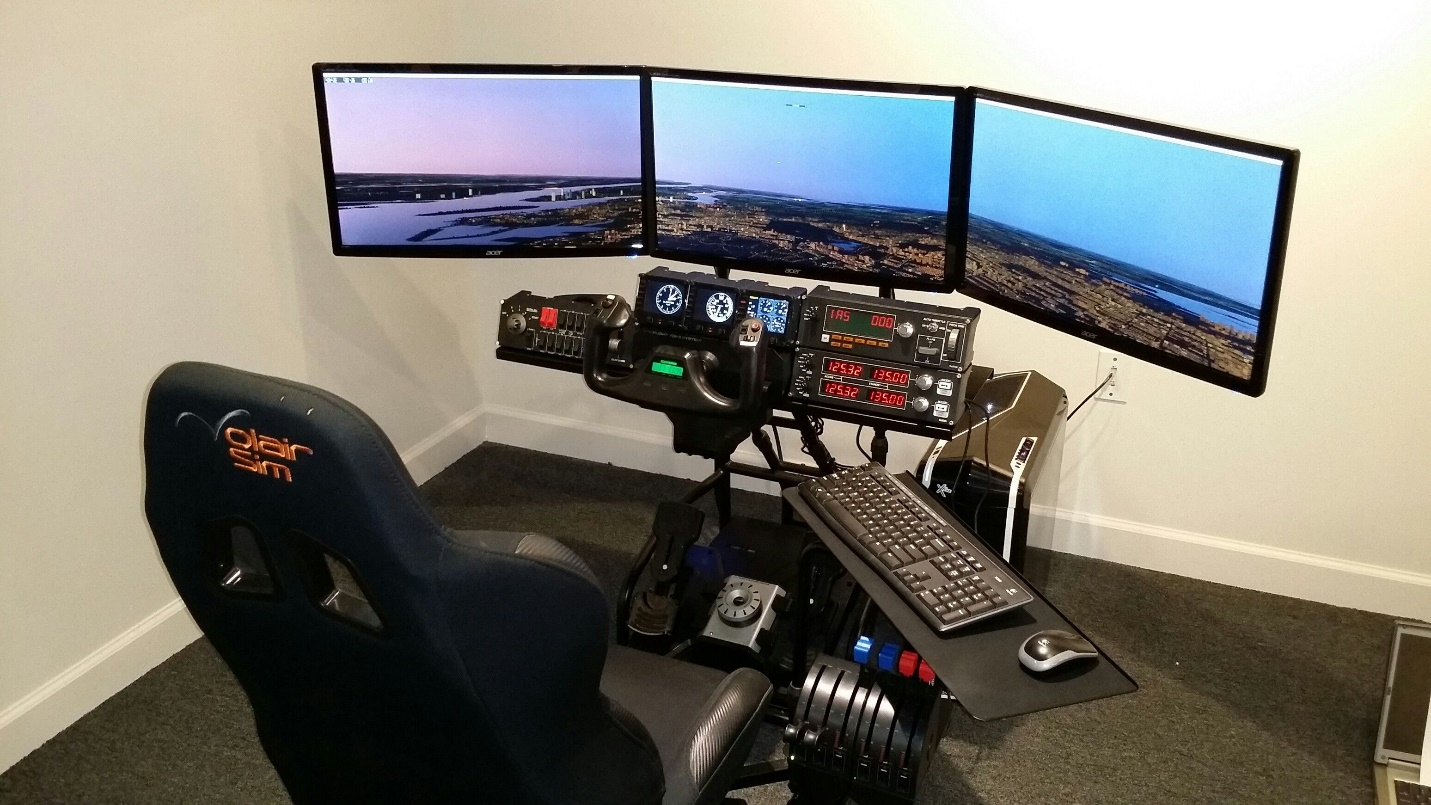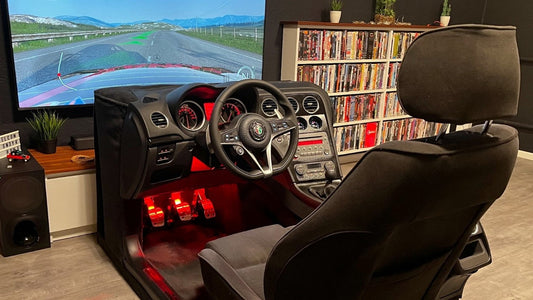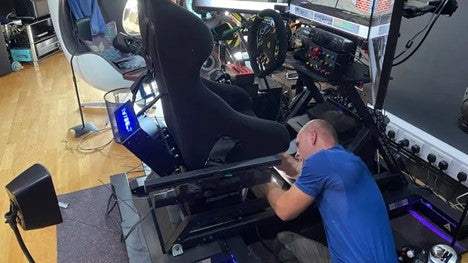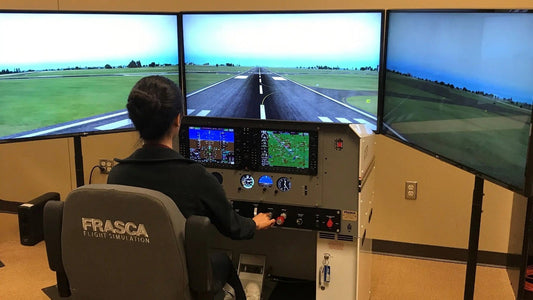Building vs Buying a Flight Simulator – All You Need to Know

Figure 1: A Home Sim Flight Setup
Dreaming of bringing a flight simulator into your home but unsure where to start? You’re in the right place! In this article, we are going to highlight all the key considerations that you need to first go through before getting started with a flight simulator.
Generally, there are two main paths. You either go hands-on with a DIY sim flight rig or opt for the convenience of a prebuilt sim flight setup from a trusted retailer. However, deciding between these paths involves more than what meets the eye. Each approach has unique factors to weigh and if you are uncertain as to what these may entail, we’ve got you covered. Ready to take off? Let’s get started!
Building a Flight Simulator
Customization to Your Needs
 Figure 2: A Custom-Built Sim Flight Setup
Figure 2: A Custom-Built Sim Flight Setup
One of the biggest advantages of building your own flight simulator is the level of customization it offers. From selecting yokes and throttle quadrants to configuring high-resolution displays and specialized avionics panels, you get to customize every component in your DIY sim flight rig to suit your exact needs.
So, whether it is you want to replicate specific aircraft models, like the Cessna 172 or Boeing 737, or recreate a unique setup to simulate challenging flight conditions, know that you can do it all with a custom-built flight rig! Prebuilt sim flight setups, on the other hand, offer limited customization and you often have to sacrifice certain features specific to your needs when purchasing them.
Control Over Budget

Figure 3: A Person Taking Out Money from Wallet
Building your own flight simulator means full control over your budget. You can freely select components that fit within your budget range and prioritize features that matter most to you, something that’s often not possible with a prebuilt sim flight setup.
For instance, if visually stunning graphics are your top priority, you might choose to invest in high-quality displays first and add advanced controls or pedals later as your budget allows. This flexibility lets you start with the basics and scale up gradually to customize each part of your DIY sim flight rig to meet your needs over time. Unlike prebuilt setups, where you might pay extra for features you don’t need, a custom build ensures that every dollar goes towards creating your ideal flight simulation experience.
Learning Experience

Figure 4: A Person Lost In Thought
While building a flight simulator is an exciting venture indeed, it is also equally a great opportunity to learn about aviation technology, flight dynamics, and hardware/software integration. This is especially valuable for long-term maintenance of your DIY sim flight rig.
For instance, if something goes wrong with one of your components, you can always fix it through your learning experience and without involving external support which is often quite heavy on your wallet. Plus, if you are an aspiring pilot or even a retired veteran, then fumbling with sim flight components could also make for a great leisure hobby.
Integration with Existing Setup

Figure 5: A Small-Scale Sim Flight Setup
If you already own some sim flight components, know that now is the right time to utilise them to make the most of your current setup. Instead of purchasing a prebuilt sim flight setup that might come with redundant parts, building your own lets you integrate what you already have into your DIY sim flight rig.
By leveraging the equipment that you have, whether it’s a yoke, throttle, or rudder pedals; you only need to purchase the parts you’re missing. This selective approach saves you from spending on extra components that come packaged with ready-made flight simulators.
Sourcing Quality Components
 Figure 6: Sim Flight Controls
Figure 6: Sim Flight Controls
Although there is no shortage of prebuilt sim racing setups out there, they often come with components that don’t meet your standards for quality or authenticity. Prebuilt systems frequently use standard-grade parts, which can be disappointing given their high price tags. You can literally equip yourself with much better gear within that budget.
Building your own DIY sim flight rig, on the other hand, gives you the freedom to source high-quality components tailored to your needs. You can choose everything from premium 4K displays and realistic controls to sturdy cockpits and rudder pedals to truly deliver yourself a top-notch immersive sim flight experience.
For instance, take the Turtle Beach VelocityOne Flight Universal Control System as shown in the picture above. On Amazon, this top-tier sim flight control system has over 1K+ 5-star reviews. Here is one such review for your reference:
“ …This Turtle Beach VelocityOne control system is SO nice, it's totally programmable, it has default settings for MSFS 2020 - and probably X-plane and the rest (DCS) of the big name sims.. it is a DREAM compared to a joystick yoke / throttle thing, it is SO much more realistic to use. I have a VR headset paired with my system and it honestly feels like I'm actually IN a cockpit flying as close to real is it gets. I got lucky and it was on sale for 329 when I picked this up, the ONLY other one I was considering was twice the price and you have to buy 2 different units to get the Yoke and then the Throttle separately. I'm sure that's 'better' but this is totally worth the price.”
Personal Satisfaction

Figure 7: A Person Flying A Plane on his Sim Flight Setup
Each component in your rig represents a choice you made and when your simulator delivers the immersive experience you envisioned, the satisfaction is unmatched. Knowing you’ve crafted something from the ground up makes each flight session more rewarding, and the happiness that comes with this accomplishment is something a prebuilt sim flight setup simply can’t offer.
Buying a Flight Simulator
Faster Implementation/Error Free
 Figure 8: A Prebuilt Sim Flight Setup
Figure 8: A Prebuilt Sim Flight Setup
A ready-made flight simulator offers the convenience of near-instant setup, allowing you to get started almost immediately after purchase. Unlike a DIY sim flight rig which often requires hands-on assembly and configuration, prebuilt sim flight setups eliminate the need for technical expertise with their simple, plug-and-play design.
Additionally, prebuilt systems are often pre-configured which helps to reduce the chances of setup errors occurring during custom assembly. While this approach may limit your customization options, it offers a reliable and efficient way to enjoy flight simulation without the hassle of a DIY build.
Proven Quality and Reliability

Figure 9: A High-quality Durable Sim Flight Setup
There is no doubt that commercial flight simulators are built by experienced manufacturers who rigorously test each unit to ensure reliability and minimize technical issues. These prebuilt sim flight setups go through stringent quality checks before they are released into the market so you can trust that each component works seamlessly together. Unlike custom builds, where you might encounter technical issues while setting up your flight sim, prebuilt rigs don’t cause such issues that often.
Even in case something goes wrong with any ready-made simulator component, there’s no need to worry because they come with valuable customer support, technical assistance, and warranties. These services offer peace of mind and practical help which spares you from potential troubleshooting frustrations.
Multi-User Training Capabilities

Figure 10: A Multi-User Sim Flight Setup
Flight simulators, unlike racing simulators, often support multi-user functionality which enables collaborative control by multiple pilots or trainees. However, setting up a multi-user configuration in a DIY sim flight rig is no child’s play. It can be very challenging, even for experienced users.
Therefore, your best bet is to look for a commercially available prebuilt sim flight setup that includes multi-user or networked training capabilities. This allows for a collaborative environment place where you can bring in your co-partners and fly the plane together!
For example, advanced multi-user rigs like the Redbird FMX offer networked capability that allows several pilots to train together in the same simulated environment.
Predictable Costs

Figure 11: Best Price Logo
Continuing with the flow, one of the key advantages of purchasing ready-made flight simulators is its predictable cost. With fixed pricing that covers hardware, software, and warranties; budget planning becomes straightforward and transparent.
Additionally, a prebuilt sim flight setup also includes technical support and maintenance plans from manufacturers which further enhances its appeal as a reliable, fixed-cost investment without hidden or unexpected expenses.
Regulatory Certification

Figure 12: FAA Website Homepage
If you are into aviation, it is much better to seek an industry-standard certified prebuilt sim flight setup. This is because many off-the-shelf flight simulators are already certified by aviation authorities, such as by the Federal Aviation Administration (FAA) or European Union Aviation Safety Agency (EASA), for pilot training purposes. This certification ensures that your simulator is recognised as a reliable training tool, providing value and legitimacy if you’re training for aviation purposes.
Final Thoughts
In the end, choosing between building or buying a flight simulator depends on your goals, budget, and technical expertise. A DIY sim flight rig offers unmatched customization and can be fully tailored to your personal needs, but it requires significant time, considerable effort, and troubleshooting skills. On the other hand, a prebuilt sim flight setup provides reliability, faster implementation, and industry certifications which makes it ideal for those who prioritise ease and professional training standards.





